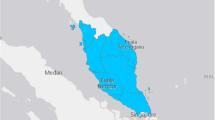Abstract
The “Sustainable Development Goals” indicate which changes nations and people of the world are committed to achieve, by virtue of a global consensus, obtained through a long, complex, and difficult path of dialogue and international and interdisciplinary collaboration. Ending poverty, in all its manifestations including its most extreme forms, through interconnected strategies, is the theme of Goal 1. Providing people all over the world with the support they need, as through promotion of social protection systems, is, in fact, the very essence of sustainable development. The objective of this work is the statistical analysis of the indicators useful for achieving the “No Poverty” Goal 1 through multidimensional statistical analysis methodologies (Totally fuzzy and relative) to understand which Italian regions need more government intervention.
The contribution is the result of joint reflections by the authors, with the following contributions attributed to L. Mongelli (Sect. 1, 4), to A. Massari (Sect. 5), to P. Perchinunno (Sect. 3.1, 3.2) and to S. L'Abbate (Sect. 2and 3.3).
Access this chapter
Tax calculation will be finalised at checkout
Purchases are for personal use only
Similar content being viewed by others
References
Istat. Rapporto SDGs. Informazioni Statistiche per l’agenda 2030 in Italia. Ed. Anno 2021. Collana: Letture statistiche – Temi (2021)
Zadeh, L.A.: Fuzzy sets. Inf. Control 8(3), 338–353 (1965)
Dubois, D., Prade, H.: Fuzzy Sets and Systems. Academic Press, Boston, New York (1980)
Cerioli, A., Zani, S.: A fuzzy approach to the measurement of poverty. In: Dagum, C., Zenga, M. (eds.) Income and Wealth Distribution, Inequality and Poverty. Springer, Heidelberg (1990). https://doi.org/10.1007/978-3-642-84250-4_18
Cheli, B., Lemmi, A.: A “totally” fuzzy and relative approach to the multidimensional analysis of poverty. Econ. Notes 24(1), 115–134 (1995)
Montrone, S., Perchinunno, P., Rotondo, F., Torre, C.M., Di Giuro, A.: Identification of hot spots of social and housing difficulty in urban areas: scan statistic for housing market and urban planning policies. In: Murgante, B., Borruso, G., Lapucci, A. (eds.) Geocomputation and Urban Planning. Studies in Computational Intelligence, vol. 176, pp. 57–78, Springer, Heidelberg: (2009). https://doi.org/10.1007/978-3-540-89930-3_4
Perchinunno, P., Rotondo, F., Torre, C.M.: A multivariate fuzzy analysis for the regeneration of urban poverty areas. In: Gervasi, O., Murgante, B., Laganà, A., Taniar, D., Mun, Y., Gavrilova, M.L. (eds.) ICCSA 2008. LNCS, vol. 5072, pp. 137–152. Springer, Heidelberg (2008). https://doi.org/10.1007/978-3-540-69839-5_11
Author information
Authors and Affiliations
Corresponding author
Editor information
Editors and Affiliations
Rights and permissions
Copyright information
© 2022 The Author(s), under exclusive license to Springer Nature Switzerland AG
About this paper
Cite this paper
Perchinunno, P., Massari, A., L’Abbate, S., Mongelli, L. (2022). Spatial Statistical Model for the Analysis of Poverty in Italy According to Sustainable Development Goals. In: Gervasi, O., Murgante, B., Misra, S., Rocha, A.M.A.C., Garau, C. (eds) Computational Science and Its Applications – ICCSA 2022 Workshops. ICCSA 2022. Lecture Notes in Computer Science, vol 13378. Springer, Cham. https://doi.org/10.1007/978-3-031-10562-3_45
Download citation
DOI: https://doi.org/10.1007/978-3-031-10562-3_45
Published:
Publisher Name: Springer, Cham
Print ISBN: 978-3-031-10561-6
Online ISBN: 978-3-031-10562-3
eBook Packages: Computer ScienceComputer Science (R0)




